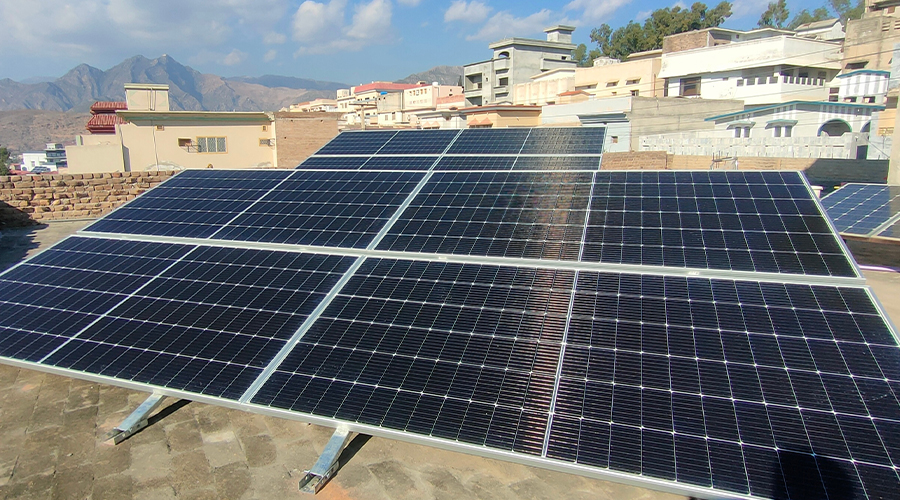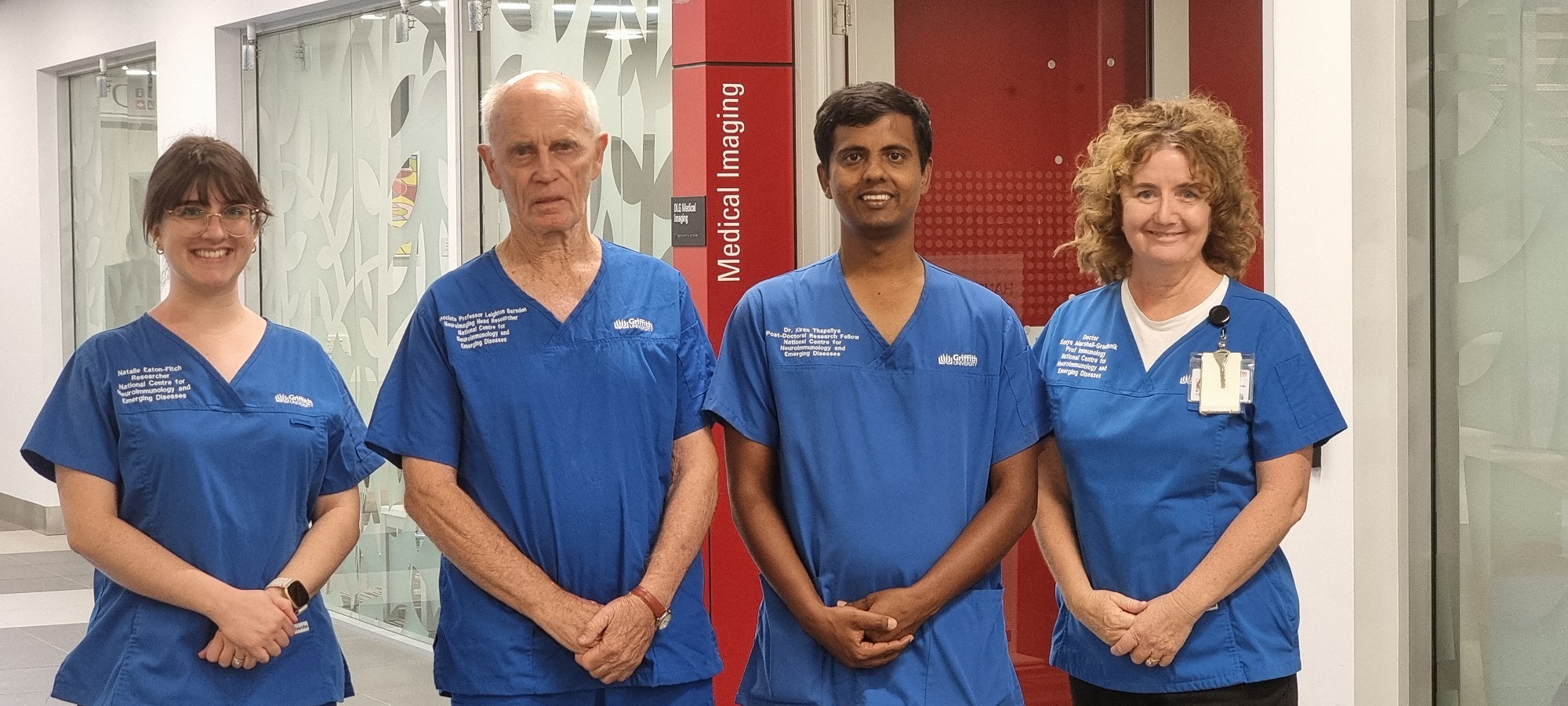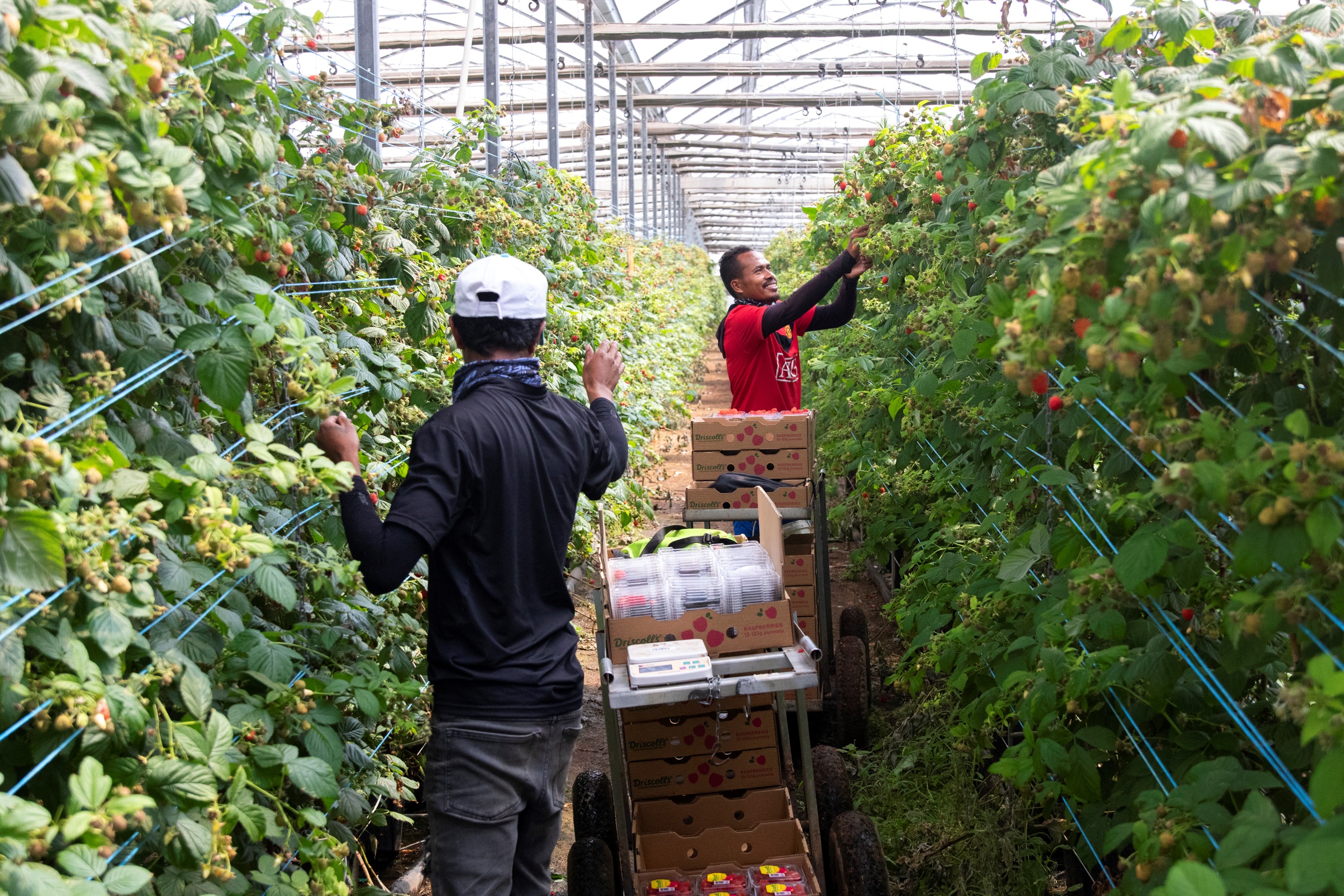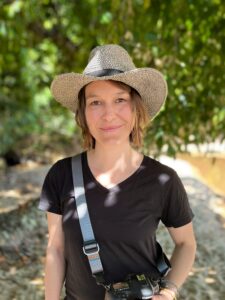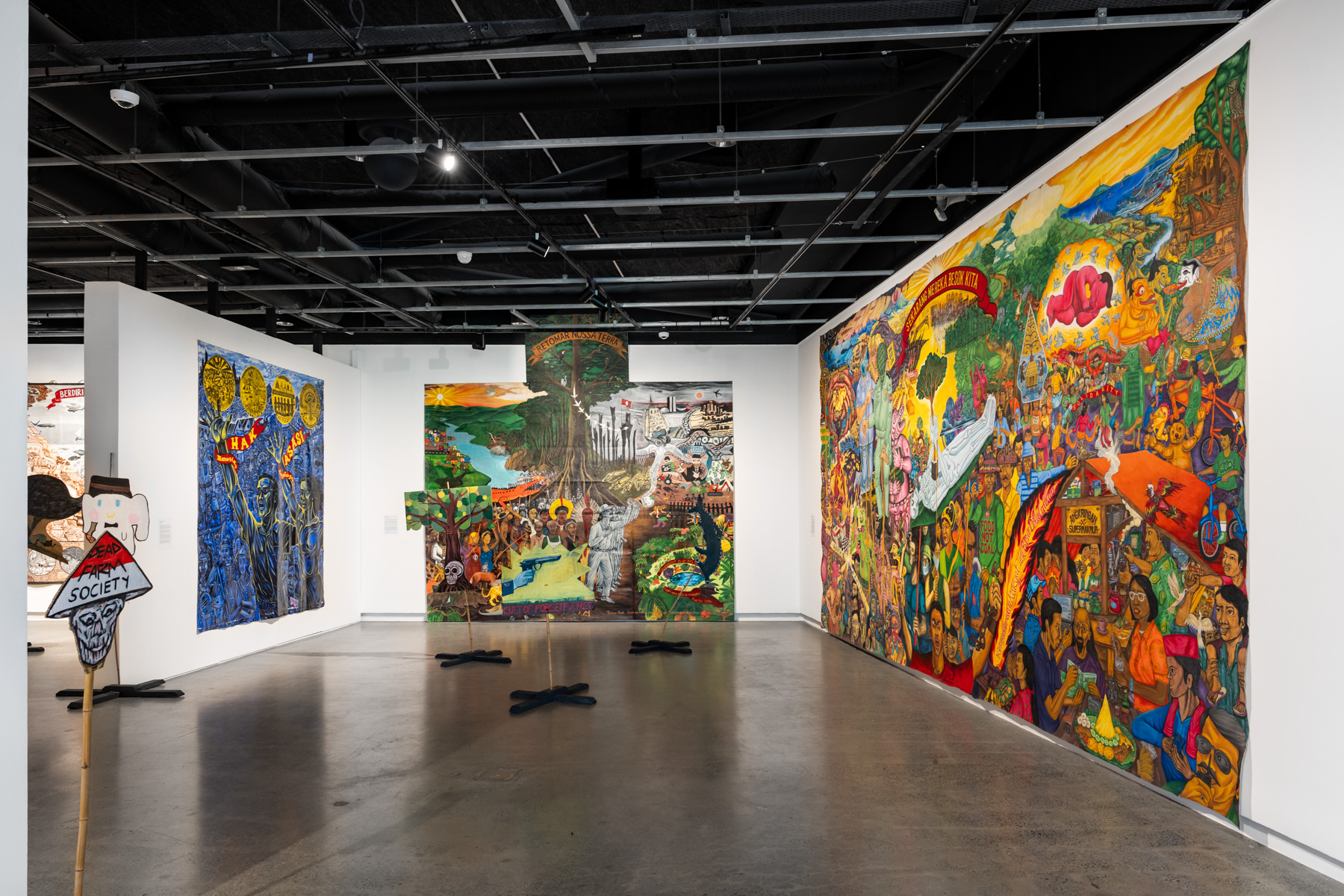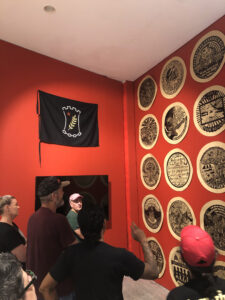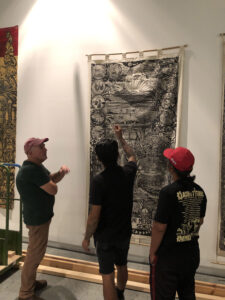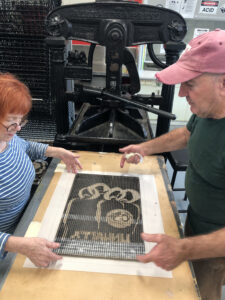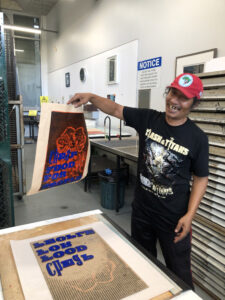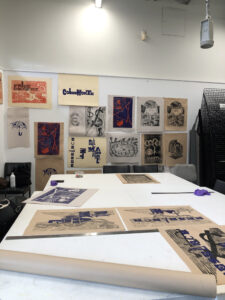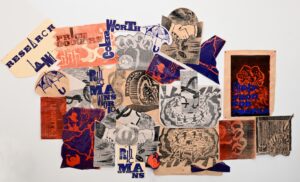Culturally enriched mediums
Taring Padi’s work reimagines facets of their Indonesian culture, deconstructing Indonesian shadow puppet traditions (wayang) and recreating them for political and street activism as a grassroots play on what is traditionally a refined art form dating back to medieval Indonesian texts and archaeological sites. In protest, these life size puppets act as a way to ‘double-up’ in numbers, providing animation and protection against opposition. In exhibition, they tell stories and represent the oppressed and marginalised people Taring Padi’s work advocates.
The UNESCO has recognised wayang tradition as an ancient form of storytelling that had been repurposed to highlight the plight of Indonesian people who suffered under Suharto’s radical political and economic rule. His dictatorship heavily censored freedoms such as freedom of the press and speech and infringed on basic human rights. His totalitarian, anti-communist state policy was also strongly supported by the USA, Israel, Germany, Great Britain, and other western nations, giving rise to Taring Padi’s ongoing critique of western ideals.
During Suharto’s reign, in May 1998 and under the oppression of his rule, university students came together to collectively resist his ongoing brutality. Civil unrest and an economic crisis all served as a catalyst for the violence that preceded Suharto’s fall.
Violence and activism swept the university campuses where students formed as a unified opposition to their militant leader. Their resistance then became visible through street activism and protest, and it is here where the tradition of wayang was repurposed by the student collectives. Collectives such as Taring Padi were one of the prominent art groups formed in this time.
The founding members of Taring Padi have shared lived experiences being students in the climate of political and social unrest which provided the fertile ground of activism to take root. Due to these experiences, their passion for initiating challenge against Suharto’s leadership and seeking ways to use their talents for meaningful change was prominent. The founding members witnessed and engaged firsthand the power of collective action to unravel dictatorial power structures. In doing so, the potential of art as a form of resistance and expression became apparent. Due to this struggle, Taring Padi’s work heavily critiques the human cost of militarism, the realities faced by rural communities and victims of state violence, oppressive power structures, environmental destruction and the western, capitalist ideals that often underpin these movements.

Decolonial Feminist Canvases: Challenging Gender, Sexuality, and Colonialism in Indonesian Art
Taring Padi’s art uses anamorphic animal imagery to cleverly challenge traditional power structures. Bastian Duarte (2012) proposed that decolonial feminism involves women who, rooted in their own histories of colonization, embrace decolonial feminist methodologies and integrate them into their indigenous struggles, lived experiences, and worldviews. In the vibrant canvases of Taring Padi’s art, Indonesian decolonial feminists boldly confront the intersections of gender, sexuality, and colonialism. Through their evocative imagery, they champion the rights and autonomy of marginalized groups, including LGBTQ+ individuals and women in minority communities. Their art serves as a powerful critique of the imposition of Western gender norms, while celebrating the diverse expressions of gender and sexuality within Indonesian society. With each stroke of their brush, they challenge societal norms and amplify the voices of those often silenced by colonial legacies, fostering dialogue, and understanding across diverse communities. Their artwork enriches the ongoing discourse on gender equality and social transformation, resonating on both global and local scales, particularly in Indonesia. During my final year as a law student, I engaged with Taring Padi, delving into the significance imbued within their artistry.
Members Fitriani and Djuwadi explain their commitment to progressive thought stating “we use art as a monologue to create more equity. We put the power of the women spirit, struggle and resistance in art… In Indonesia, it is quite difficult to talk about differences of identities. The religious fundamentalist attack us on our empowering art for women… We put this information through social media and one of the fundamentalists attacked us. The landlord kicked us out of the space we rented. The police come with the fundamentalist and cleric leaders shouted “you will go to hell” because they see us in our shorts with tattoos. In Indonesia, it is quite difficult to talk about this monologue and it is a very big challenge to talk about identities”.
In interview with Taring Padi members, the difficulties of dealing with different aspects of people’s identities, especially in Indonesia where some may follow strict religious beliefs, became clear. However, it is apparent that there is a commitment to being inclusive, dealing with issues related to LGBTQIA+ movements, and learning to understand theirs and other communities better with a commitment to progressive thought.

Indonesian censorship
In Indonesia, the legal landscape governing political art has been and is a complex and often restrictive battle. Indonesian artists have not always had freedoms of expression or freedom of speech rights due to a combination of censorship laws – particularly under Suharto’s rule – and restrictions by galleries and art fairs which strongly favored apolitical work.
While Indonesia has a constitutionally guaranteed right to freedom of expression, this right is frequently curtailed by the outlawing of dissent or criticism of the government. There are, for example, laws which grant authorities broad powers to censor online content they consider blasphemous or defamatory despite a claimed constitutional right to freedom of expression. Additionally, laws against sedition and blasphemy are routinely used to silence political activists and artists who challenge the status quo. As Amnesty International found in early 2024 amidst the presidential election, “Indonesia continues to fail to guarantee people’s rights to express their opinions peacefully amidst a shrinking civic space”.
Some artworks by Taring Padi have sparked legal controversy in Indonesia due to their provocative and politically charged content, such as in 2010 when a Taring Padi mural located in Yogyakarta was deemed “politically sensitive” by officials and its removal was ordered. The decision to censor the artwork sparked outrage among supporters of Taring Padi and raised questions about freedom of expression and censorship in Indonesia.

Ethos, ideals and international censorship
Taring Padi’s interdisciplinary practice spans art, music, and theatre and has seen their work included in exhibitions internationally, including Framer Framed, in The Netherlands in 2023, and documenta fifteen in Germany in 2022. They are known for their grand scale reclaiming of open spaces, used as canvas for their collective message. Their message brings awareness to the police brutality, exploitative practices and rights deprivations in both their home nation of Indonesia and the nations within which they are exhibiting.
This same process is again visible at their current Tanah Tumpah Darah exhibition in Brisbane, Australia where they have collaborated with Aboriginal art collective proppaNow in solidarity to create the banner that now hangs outside the Griffith University Art Museum. The banner depicts recurring motifs, critiques of capitalism and colonialism, poverty, environmental injustices, and the realities of urban poor communities both in Australia and Indonesia.
Taring Padi’s process of visual storytelling often illustrates politically explicit imagery which can, and has, evoked impassioned responses. In political discourse, these works and their responses can be considered both constructive or destructive, educative or indoctrinating, but nevertheless a facet of public debate. However, questions arise when censorship or removal via legal or social intervention takes place. In such circumstances, the debate is not only obstructed, but it initiates a complicated freedom of speech dialogue too.
Think: how valuable is Nick Ut’s ‘Napalm Girl’ to the political discourse, historical recollection and documentation of the Vietnam war? A photograph that, if censored, would have removed much depth from our reflections of history. Indeed, there is no amount of discussion or words that would otherwise capture what that piece of art did. What’s important is how art adds something, motivates and rouses where other mediums that contribute to the political discussion may not. This work, and the work of Taring Padi do not substitute for the lived experiences or struggles of those depicted, however they do further our understanding of the political issues imagined, making us more critical and reflective of our own positions.
Think: where were you when you first watched Rabbit Proof Fence? I was a child, none the wiser to the atrocities of this world and humankind. The school curriculum at the time taught an ambiguous history and there was no real connection to the brutality that permeates Australia and its development. Until this film. The tears, sadness, and anger this film invoked in me as a child could only come from an emotive means of political discourse. This was particularly so where school teachers and school officials remained protective of the Australia they wished to recall. If the film and its realities had been suppressed and censored like it had been for years prior, would our understanding and education of these truths have been enriched as they were?
To devalue the impact of this communicative style on political discourse at large by censorship, suppression or removal goes against the public interest, our cultural responsibilities and the political freedoms and free speech rights we hope to think we have. Albeit the documenta fifteen controversy is steeped in a sensitive history, however should those historical truths be the cause of censoring current controversies?
Taring Padi clarified that the 2002 People’s Justice banner was crafted to protest the military rule and violence of the Suharto dictatorship. The military figures depicted symbolized corrupt government officials and aggressive military leaders. Taring Padi expressed regret and offered apologies, emphasizing that the banner was not intended to be linked to anti-Semitism. They lamented that some individuals interpreted it differently from its original intent and expressed remorse for any distress caused. Consequently, they opted to conceal the artwork. In another work at documenta fifteen initially a character depicted wore a topi haji, a hat worn by religious leaders in Indonesia. However, in June 2022, Taring Padi changed it to a peci, a traditional Indonesian hat, following the removal of the People’s Justice banner. This adjustment aimed to prevent misunderstandings or offense, such as being mistaken for a kippah.
Taring Padi’s work serves as a vehicle for collective mobilisation and cultural resistance where perhaps other mediums struggle. Their art provides the medium that carries a message that can only be delivered in this form, much like the photograph and film discussed. Their work provides for an unwavering commitment to grassroots activism, ongoing efforts to challenge what may be considered otherwise ‘unchallengeable’, and truth telling.

Blog post by AEL Summer Scholarship student Rudolf Orbacedo. Photography by AEL Summer Scholarship student Moana Danger.
Taring Padi: Tanah Tumpah Darah is on at Griffith University Art Museum from 29 February to 25 May 2024. More information can be found here.
